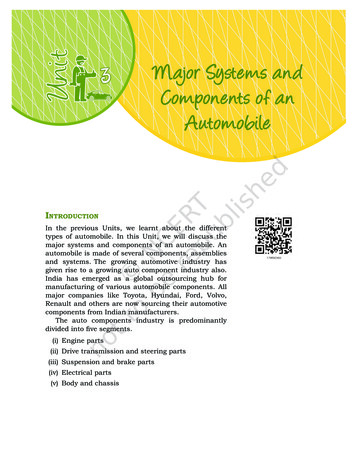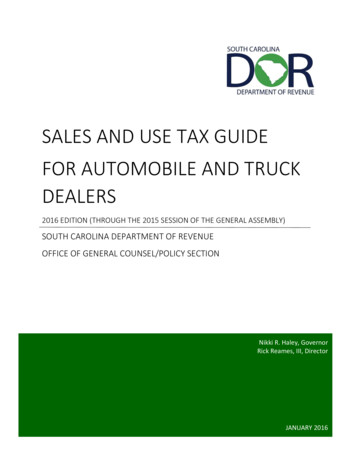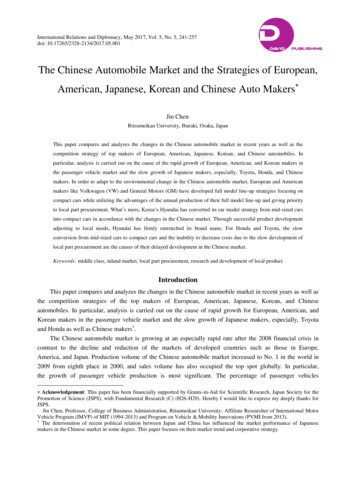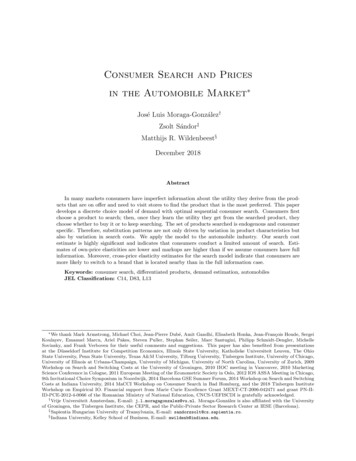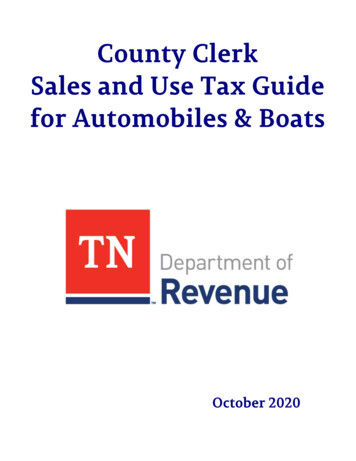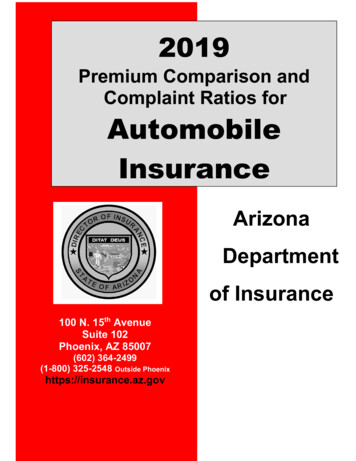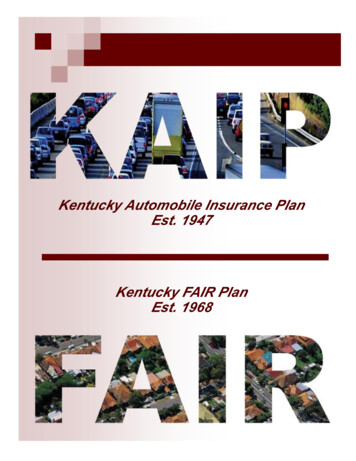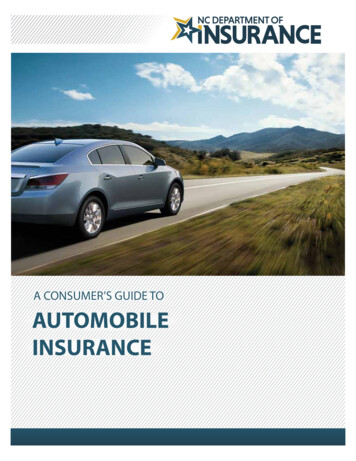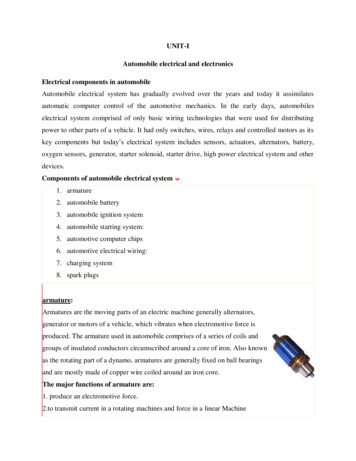
Transcription
UNIT-IAutomobile electrical and electronicsElectrical components in automobileAutomobile electrical system has gradually evolved over the years and today it assimilatesautomatic computer control of the automotive mechanics. In the early days, automobileselectrical system comprised of only basic wiring technologies that were used for distributingpower to other parts of a vehicle. It had only switches, wires, relays and controlled motors as itskey components but today’s electrical system includes sensors, actuators, alternators, battery,oxygen sensors, generator, starter solenoid, starter drive, high power electrical system and otherdevices.Components of automobile electrical system1. armature2. automobile battery3. automobile ignition system4. automobile starting system:5. automotive computer chips6. automotive electrical wiring:7. charging system8. spark plugsarmature:Armatures are the moving parts of an electric machine generally alternators,generator or motors of a vehicle, which vibrates when electromotive force isproduced. The armature used in automobile comprises of a series of coils andgroups of insulated conductors circumscribed around a core of iron. Also knownas the rotating part of a dynamo, armatures are generally fixed on ball bearingsand are mostly made of copper wire coiled around an iron core.The major functions of armature are:1. produce an electromotive force.2.to transmit current in a rotating machines and force in a linear Machine
automobile battery:Automobile battery refers to an electrochemical device comprising of primaryand secondary cells that are used for transforming chemical energy intomechanical energy. Most of the vehicles today uses ‘lead acid’ batteries.Batteries are mostly of two types i.e. Non-rechargeable and rechargeable. Oftencalled as disposable batteries, non-rechargeable batteries are used once andthen dumped. While rechargeable batteries are those devices that can be easilyrecharged by applying electrical current that turns or reverses a chemicalreaction. A normal battery has an initial voltage of about 1.6 volts and producesbetween 500-1000 amps. The market size of automobile battery industry isworth us 48 billion a year. China, hong kong, united states, india and taiwanare the major battery manufacturing countries on the global platform.Classification of various components of a battery includes:battery boxesbattery cablebattery cable terminalsbattery control systemsbattery platesbattery traysperformance batteriesvoltage regulatorsground strapsbattery switchesautomobile ignition system:Automobile ignition system constitute of various devices, tools and componentsthat are used for igniting the fuel in an internal combustion engine of a vehicle.In this system, electric current is used for burning the mixture of air and fuelwith the help of coil, battery, and spark plug. Ignition system is assembled inonly those automobile engines, which operates with the help of petrol orgasoline. The two main functions of automobile ignition system are to produceenough voltage so that it can easily create a spark for burning air/fuel mixtureand secondly it exercises control over the timing of spark and transmit it to theapt cylinder. A typical automobile ignition system produces voltage somewherebetween 20000 volts and 50000 volts from a 12-volt source. Automobile ignitionsystem can be further classified into three main heads such as mechanical
ignition system, electronic ignition system and distributor less ignition system.Most of the vehicles today incorporate electronic ignition system in its engine.Major components used in automobile ignition systems are:coil wiresignition boxignition distributormagnetoignition switchignition coil partsignition coilselectronic timing controllersignition controllermagnetoautomobile starting system:Automobile starting system is considered to be the heart of automobile electricalsystem. The starting system of an automobile includes those devices, which areused for initiating an engine of a vehicle. Once the key is put into the ignitionswitch then the current pass through battery cables to starter motor. After this,starter motor turn the engine and the downward moving piston create suctionwhere air and fuel mixture is burned and then the engine starts.The chief components of automobile starting system are:starterstarter drivestarter solenoidbendix drive starterautomotive computer chips:Automotive computer chips also known as super chip, automotive computerchips are basically the integrated circuits made of semi conducting material thatare used for storing a new engine management program in the electronic controlunit of the vehicle. These chips stores the data used by engine control unit, formanaging and controlling the engine functions. Oxygen sensor is one of thetypes of automobile computer chips that form an important part of the enginefuel control feedback loop. Automotive computer chips comprises of:engine management systemssensor ring
oxygen sensorsOther automobile computer chips include:Power train control modulesPerformance monitorstunersperformance chipsspeedometer calibratorstop speed eliminatorsflip switchesshift improversautomotive electrical wiring:The electrical wiring system of an automobile incorporate different types ofdevices, flexible electrical wires, electrical fuses, connectors, fuse blocks usedfor fastening one end of an automobile component to the power source device.These electrical wiring components are used for bearing mechanical loads andtransmitting communication signals or electrical energy.Apart from electrical wiring components mentioned above, there are otherparts used in an automobile electrical system like:electrical fuseelectrical fuse holderselectrical switch panelselectrical switchesfuse blocksrelay connectorsshrink sleeve tubingwiring connectorwiring harnesseselectricalswitch coversa/c harnessground strapselectrical switches partscharging system:The charging system of an automobile has three basic components such asalternator, regulator, and the interconnecting wiring. The main function ofautomobile charging system is to control and regulate the charge in the battery ofa vehicle. Automobile charging system generally generates a voltage between13.5 and 14.4 volts when the engine is working. It produces electrical current foroperating automobile lights, music systems, heater, engine electrical system and
other electrical components.Other components of charging system of the vehicle are:alternatorAlternator bearingautomobile generatoralternator fansalternator partsspark plugs:A spark plug is a small electrical device that is implanted into internalcombustion engine cylinder for burning the mixture of air and fuel. A typicalspark plug consists of a center electrode, metal casing and a ground electrodeas illustrated in the figure. These plugs are used in many machines such astrucks, buses, tractors, boats, aircraft, motorcycles, scooters, industrial and oilfield engines, and oil burners. The basic raw materials used for manufacturingspark plugs are aluminum oxide, steel, silver, gold, platinum, copper and otherhigh nickel alloys. These spark plugs are available in different configurationsand heat ranges to adapt to any type of engine.Other spark plug components are:spark plug partsspark plug toolsElectronic diesel controlEdc distributor injection pumpspark plug wires
Electronic diesel control is a diesel engine fuel injection control system for the precise meteringand delivery of fuel into the combustion chamber of modern diesel engines usedin trucks and cars.Contents introduction system overview components operation additional functions referencesIntroductionEdc injection inline pumpThe mechanical fly-weight governors of inline and distributor diesel fuel injection pumps used tocontrol fuel delivery under a variety of engine loads and conditions could no longer deal with theever increasing demands for efficiency, emission control, power and fuel consumption. Thesedemands are now primarily fulfilled by the electronic control, the system which provides greaterability for precise measuring, data processing, operating environment flexibility and analysis toensure efficient diesel engine operation. The edc replaces the mechanical control governor withan electro-magnetic control device.The edc is divided into these main groups of components.
electronic sensors for registering operating conditions and changes. A wide arrayof physical inputs is converted into electrical signal outputs. actuators or solenoids which convert the control unit's electrical output signal intomechanical control movement. ecm (electronic control module ) or engine ecu (electronic control unit) with microprocessorswhich process information from various sensors in accordance with programmed softwareand outputs required electrical signals into actuators and solenoids.Components]Edc accelerator pedal assemblysensors Injection pump speed sensor - monitors pump rotational speed Fuel rack position sensor - monitors pump fuel rack position Charge air pressure sensor - measures pressure side of the turbocharger Fuel pressure sensor Air cleaner vacuum pressure sensor Engine position sensor Temperature sensors - measure various operating temperatures Intake temperature Charge air temperature Coolant temperature Fuel temperature
exhaust temperature (pyrometer) Ambient temperature Vehicle speed sensor - monitors vehicle speed Brake pedal sensor - operates with cruise control, exhaust brake, idle control Clutch pedal sensor - operates with cruise control, exhaust brake, idle control Accelerator pedal sensor Driver input switches - cruise control, idle increase /decrease, engine/exhaust brake Injector needle movement sensor - monitors the actual injection time and feeds theinformation to the ecu (as used on vm motori 2.5 and 3.1 engines)electronic control unitEdc control unitThe ecu collects and processes signals from various on-board sensors. An ecu electronic modulecontains microprocessors, memory units, analog to digital converters and output interface units.Depending upon the parameters, a number of different maps can be stored in the onboardmemory. This allows the ecu to be tailored to the specific engine and vehicle requirements,depending on the application. The operating software of the ecu can be adapted for a widevariety of engines and vehicles without the necessity of hardware modification. The ecu isusually located in the cab or in certain cases, in a suitable position in the engine bay whereadditional environmental conditions might require cooling of the ecu as well as a requirement forbetter dust, heat and vibrations insulation .
actuators and solenoidsEdc pump actuatorElectro-magnetic actuators are usually located on the fuel pump to transfer electrical signals intomechanical action in this case fuel rack actuator and or fuel stop solenoid which means thatdepending on requests from control unit full fuel or no fuel quantity. Injectors Boost-pressure actuator Intake-duct switchoff Throttle-valve actuator Exhaust-gas recirculation actuator Auxiliary heating A/c compressor Radiator fan Electronic shutoff valve Rail-pressure control valve Diagnosis lampOperationThe injection of fuel or the quantity of injected fuel has a decisive influence on engine starting,idling, power and emissions. The engine ecu is programmed ("mapped") with relevant data towhere the fuel rack position has an equivalent signal for the amount of fuel being injected. Thedriver requests the torque or engine speed requirements via accelerator pedal potentiometerthereby sending a signal to the engine ecu which then, depending on its mapping and data
collected from various sensors, calculates in real time the quantity of injected fuel required, thusaltering the fuel rack to the required position. The driver can also input additional commandssuch as idle speed increase to compensate e.g. For ptooperation which can be either variably setor has a preset speed which can be recalled. The road speed function can be used to evaluatevehicle speed and possibly activate a speed limiter (heavy vehicles), or maintain or restore a setspeed (cruise control). Further functions can include exhaust brake operation which, whenactivated, will result in the fuel pump rack position being set to zero delivery or idle. The engineecu can also interface with various other vehicle systems e.g. Traction control and carry out selfmonitoring duties and self diagnostic functions to keep the system working at an optimal level.To ensure the safe operation in case of failure, the limp home mode functions are also integratedinto the system, e.g. Should the pump speed sensor fail the ecu can use an alternator speed signalfunction for engine rpms counter as a backup signal.Additional functions Engine protection, cold start - when starting cold, engine rpms are limited. Engine protection, overheating - when overheating, to avoid damage the engine poweroutput is limited. Remote engine shutdown - when auxiliary equipment is in use e.g. Crane in case of rollover. Constant engine speed - the engine maintains set revs irrespective of load e.g. Pto operationEnvironmental legislation for pollutionAir pollution control ordinanceThis ordinance empowers the epd to control air pollution from industry, commercialoperations and construction work. [motor vehicle emissions are controlled under the roadtraffic ordinance and the epd also helps to control these]. The apco prohibits the use ofhigh sulphur and leaded fuels and the open burning of construction waste, tyres and cablesfor metal salvage.Abatement notices are usually issued to anyone causing air pollution from a process ormachinery and they will be asked to reduce or stop their emissions, or face prosecution.
Some events are prosecuted on the spot, such as construction dust or black smokeemissions. Potential polluters whose fuel consumption exceeds a certain limit must submitplans for installing or altering furnaces, ovens and chimneys. Major industrial processes,or "specified processes", are subject to tighter control. The methods and standards forassessing air pollution can be found in the technical memorandum for issuing air pollutionabatement notices.Asbestos control provisions in the ordinance require that building works involvingasbestos must be conducted only by registered qualified personnel and under thesupervision of a registered ounds)regulation:the regulation prohibits import into hong kong and manufacture in hong kong regulatedproducts with volatile organic compounds content exceeding the prescribed limits for localsale or use. The regulated products include architectural paints, vehicle refinishing paints,vessel paints, pleasure craft paints, adhesives, sealants, printing inks and six categories ofconsumer products (namely air fresheners, hairsprays, multi-purpose lubricants, floor waxstrippers, insecticides, and insect inery)(emission)regulation:this regulation covers non-road mobile machinery (nrmms) include a wide range of mobilemachines (including transportable industrial equipment), or vehicles powered by internalcombustion engines used primarily off-road. All regulated machines sold or leased for usein hong kong, except those exempted, are required to comply with the prescribed emissionstandards. Starting from 1 december 2015, only approved or exempted nrmms with aproper label are allowed to be used in specified activities and locations includingconstruction sites, container terminals and back up facilities, restricted areas of the airport,designated waste disposal facilities and specified uelatberth)regulation:this regulation bans ocean going vessels from using fuel with sulphur content exceeding0.5% during berthing in hong kong.
T is prohibited to dump waste in public places or on government land, or on privatepremises without the consent of the owner or occupier. Apart from this general provision,there are four major provisions under the waste disposal ordinance:waste disposal (chemical waste) (general) regulation:anyone who produces chemical waste or causes it to be produced has to register as achemical waste producer. The waste must be packaged, labelled and stored properly beforedisposal. Only a licensed collector can transport the waste to a licensed chemical wastedisposal site for disposal. Chemical waste producers also need to keep records of theirchemical waste disposal for inspection by epd staff.Waste disposal (livestock waste) regulations:livestock farmers must dispose of livestock waste without causing pollution or nuisance tothe environment. Liquid waste has to be disposed of either to a soakaway-pit or treated tomeet effluent standards of 50 mg/l of biochemical oxygen demand and 50 mg/l ofsuspended solids.Import and export of waste control:a permit system to control the import and export of hazardous and other waste in line withthe requirements of the basel convention, is set out in this ordinance.Waste disposal (clinical waste) (general) regulation:clinical waste producers must properly manage their clinical waste by consigning theclinical waste to licensed clinical waste collectors for delivery to a licensed disposalfacility for disposal. The waste must be packaged, labeled and stored properly beforedisposal. Only a licensed collector can transport the waste to a licensed clinical wastedisposal site for disposal. Clinical waste producer also need to keep records of theirclinical waste consignment and delivery records for inspection by epd staff.All discharges, other than domestic sewage to a foul sewer or unpolluted water to a stormdrain, must be covered by an effluent discharge licence. The licence specifies thepermitted physical, chemical and microbial quality of the effluent and the general
guidelines are that the effluent does not damage sewers or pollute inland or inshore marinewaters. Details of the effluent standards can be found in the technical memorandum oneffluent is charges.Legal controls also apply to sewerage connections. The government is extending publicsewers to some major rural areas in an effort to improve the environment there. In areaswhere these new sewers become available, a notice would be issued asking owners toconnect their sewage to the public sewer. If necessary, a further notice may be issuedasking the owner to demolish or fill in any redundant sewage treatment facilities or septictanks and soakaway-pits.Neighborhood noise and noise from construction, industrial and commercial activities arecontrolled by the noise control ordinance. Neighbourhood noise in the context of providingquick relief to the public is generally controlled by the police.Construction noise:noisy construction work and the use of powered mechanical equipment in populated areasis not allowed between 7pm and 7am or at any time on general holidays, unless priorapproval has been granted by the epd through the construction noise permit system.Certain equipment is also subject to restrictions when its use is allowed. Hand-heldpercussive breakers and air compressors must comply with noise emissions standards andbe issued with a noise emission label from the epd. Percussive pile-driving is allowed onweekdays only with prior approval, in the form of a construction noise permit from theepd.Industrial and commercial noise:industrial and commercial noise must comply with statutory limits specified in thetechnical memorandum. Operators who fail to do so will be issued with a noise abatementnotice asking them to reduce their noise or face prosecution for failing to comply with theconditions in the notice.This ordinance controls the production, import and export of products containing ozone-
depleting substances, and the recycling of ozone-depleting substances, thereby givingeffect to hong kong's international obligations under the 1985 vienna convention and the1987 montreal protocol.Anyone involved in marine dumping and related loading operations, requires a permitfrom the epd. All dumping vessels have to be equipped with an automatic self-monitoringsystem which records their position and loading and dumping operations.The environmental impact assessment ordinance is to avoid, minimize and control theadverse impact on the environment of designated projects through the application of theenvironmental impact assessment process and the environmental permit system.Designated projects, unless exempted, must follow the statutory environmental impactassessment (eia) process and require environmental permits for their construction andoperation.The ordinance regulates, through an activity-based permit system, the import, export,manufacture and use of non-pesticide hazardous chemicals that have potentially harmful oradverse effects on human health or the environment, including those regulated by thestockholm convention and the rotterdam convention.Producer responsibility scheme (prs) is a key policy initiative under the holistic wastemanagement system for waste reduction, recovery and recycling. Enshrining the principleof "polluter pays" and the element of "eco-responsibility", prs requires manufacturers,importers, wholesalers, retailers and consumers to share the responsibility of reducing,recovering and recycling certain products so as to minimize their environmental impact.The ordinance is a framework legislation which provides the shared core elements of allprss and the fundamental regulatory requirements in respect of individual types of product,with operational details to be set out in the ordinance and its subsidiary legislation.The environmental levy scheme on plastic shopping bags is the first prs under theordinance, and the law sets out the details of the operation of the prs. Starting from 1 april2015, the prs is fully extended to cover all retail sales of goods. Sellers involving in retail
sales of goods shall charge the customer 50 cents or more for each plastic shopping bagprovided directly or indirectly to the customer. Offenders may be subject to a fixed penaltyof 2,000.The ordinance prohibits drivers from causing or permitting their vehicle engines to operatefor more than 3 minutes in aggregate in any 60-minute period while the vehicles arestationary ("idling prohibition"). Drivers who contravene the idling prohibition may beissued with a penalty notice requiring them to pay a fixed penalty of 320. Traffic wardensand environmental protection inspectors are empowered to enforce the law.Overview of electronic systemElectrical and electronic system content in both automotive and commercial vehicles willcontinue to become more complex as new technologies are accepted and implemented. Fromvehicle level integration requirements to individual subsystem and component design validation,exponent’s vehicle electronics group has significant expertise and industry experience thatincludes powertrain, body, chassis, safety, and entertainment electrical and electronic systemshardware and software. Our staff has experience designing and analyzing vehicle wiring andcircuits, starting and charging systems, batteries, motors, switches, lamps, internal combustionand hybrid engine management systems, instrumentation, power mirrors and windows, automaticheadlamp aiming, heads-up display, electric assist power steering, wireless tire pressuremonitoring, electronic suspension control, antilock brakes, electronic stability control, tractioncontrol, electronic throttle control, electric brake systems, passive seat belt systems, mobilecommunication systems, and front and side multi-stage supplemental restraint systems. Exponentpersonnel are versed in the failure modes of high duty cycle sensors and actuators, both inert anddetrimental effects of electromagnetic interference, and relevant mitigation methods.Exponent engineers and scientists are trained in taguchi’s robustness design practices includingtotal cost function, control factors, and life cycle cost management. In order to optimize productdesign, validation, and life testing processes for vehicle electronic systems, our engineers haveimplemented the design of experiments and are capable of exploring factors not understood orpreviously considered during initial product design and development. Exponent’s professionalshave experience with methods for proactively reviewing designs of vehicle systems, such asfailure mode and effect analysis (fmea), and with methods of failure analysis, such as fault tree
analysis (fta). We are often able to leverage our rich history of failure analysis experience todesign reviews to help our clients evaluate new systems.From vehicle-level integration requirements to individual subsystem and component designvalidation, exponent’s professionals have significant expertise and industry experience: Powertrain control systems Body control systems Braking control systems Engine control systems Chassis control systems Safety systems Entertainment systems Vehicle power and battery systemsOur consulting services include designing and analyzing: Vehicle wiring and circuits Starting and charging systems Batteries Actuators, motors, switches, and indicators Internal combustion and hybrid engine management systems Instrumentation Power mirrors and windows Automatic headlamp aiming Heads-up display Electric assist power steering Seat heating systems Wireless tire pressure monitoring Electronic suspension control Antilock brake systems Electronic stability control Traction control Electronic throttle control Electric brake systems
Passive seat belt systems Mobile communication systems Front and side multi-stage supplemental restraint systemsPower train sub systemHigher performing power train & engine system componentsThe drive to reduce emissions and improve fuel economy is urgent, making every powertrain andengine system component a candidate to improve efficiency, integrate function, reduce weightand lower cost – areas where dupont excels.Materials play a critical role in helping to reduce emissions, boost fuel economy and improveefficiency in power train technologies. Dupont offers the broadest portfolio of materials capableof withstanding today’s harsh engine environments and the most experienced and globaldevelopment staff to ensure solutions developed today are on the road tomorrow. Increasing performance in automotive air ducts and turbocharger hoses Leading the metals-to-plastics revolution in transmissions and driveline Enhanced durability for extreme environments for sealed engine covers Improving power train efficiency in charged air coolers Thermal management through lighter weight engine cooling systemsAutomotive chassis sub systemAutomotive chassis is a skeletal frame on which various mechanical parts like engine, tires,axle assemblies, brakes, steering etc. Are bolted. The chassis is considered to be the mostsignificant component of an automobile. It is the most crucial element that gives strength andstability to the vehicle under different conditions. Automobile frames provide strength andflexibility to the automobile. The backbone of any automobile, it is the supporting frame towhich the body of an engine, axle assemblies are affixed. Tie bars, that are essential parts ofautomotive frames, are fasteners that bind different auto parts together.automobile frames, automobile chassis automotive tie bar’And tractor linkages parts
automobile framesAutomotive frames are basically manufactured from steel. Aluminum is another raw materialthat has increasingly become popular for manufacturing these auto frames. In an automobile,front frame is a set of metal parts that forms the framework which also supports the front wheels.It provides strength needed for supporting vehicular components and payload placed upon it.Types of automobile framesbonnethoodbonnet:Bonnet, an important part of automotive frame can be defined as a protective covering made upof a hinged metal part used for covering an engine of a vehicle. Usually automobile bonnets aremade of steel, aluminum, fiberglass, and carbon fiber reinforced plastic.hood:Hood refers to a cover placed over the engine and passenger compartment of an automobile.Hoods form an important type of automotive frames. These auto frame parts are usually made ofsteel, aluminum, fiberglass, carbon fibre or dry carbon. A typical hood comprises of severaldifferent parts such as hood ornament, hood scope, power bulge, and wiper jets.automobile chassisAutomotive chassis is considered to be one of the significant structures of an automobile. It isusually made of a steel frame, which holds the body and motor of an automotive vehicle. Moreprecisely, automotive chassis or automobile chassis is a skeletal frame on which variousmechanical parts like engine, tires, axle assemblies; brakes, steering etc are bolted. At the time ofmanufacturing, the body of a vehicle is flexibly molded according to the structure of chassis.Automobile chassis is usually made of light sheet metal or composite plastics. It providesstrength needed for supporting vehicular components and payload placed upon it. Automotivechassis or automobile chassis helps keep an automobile rigid, stiff and unbending. Auto chassisensures low levels of noise, vibrations and harshness throughout the automobile. The different
types of automobile chassis include:ladder chassis: ladder chassis is considered to be one of the oldest forms of automotive chassisor automobile chassis that is still used by most of the suvs till today. As its name connotes,ladder chassis resembles a shape of a ladder having two longitudinal rails inter linked by severallateral and cross braces.Backbone chassis: backbone chassis has a rectangular tube like backbone, usually made up ofglass fibre that is used for joining
automatic computer control of the automotive mechanics. In the early days, automobiles electrical system comprised of only basic wiring technologies that were used for distributing power to other parts of a vehicle. It had only switches, wires, relays and controlled motors as its key comp
